Grand Piano Masters · Piano Concertos by Beethoven & Ustvolskaya
Piano Concertos by Beethoven & Ustvolskaya
Ludwig van Beethoven (1770-1827):
Piano Concerto No. 2 in B-Flat Major, Op. 19
World Premiere Recording of the version for Piano & String Orchestra
by Vinzenz Lachner (1811-1893)
Galina Ustvolskaya (1919-2006):
Concerto for Piano, Strings & Timpani
With courtesy of Hans Sikorski Music Publishing Hamburg
Patricia Hase (Piano) · Ensemble Galina
Conductor: Peter Leipold
A concert recording from the Richard-Jakoby-Hall
of the Hanover University of Music, Drama & Media in Germany
HD Recording · DDD · c. 49 Minutes



Ludwig van Beethoven: Piano Concerto No. 2 in B-Flat Major, Op. 19
It can now be assumed, that on the 29th of March 1795 what is now known as the second concerto in B flat major Op. 19 was presented to the Viennese public in Hofburgtheater. Announced was "a new concerto on the pianoforte, played and composed by the maestro, Herr Ludwig van Beethoven". The origins of the composition date back to the year 1790. At that time Beethoven was living in Bonn and had begun to give many concertos as a soloist - in Bonn, Vienna and on tour. The concerto went through four different versions before it was first printed in 1801. Further versions were developed between 1793 and 1794, when the third movement was added, as we know it today. This Rondo, in 6/8 measure, exhibits particularly significant features. First the metric shift of the main theme, which creates an unusual syncopation; the first note appears on the first metric beat and not as an upbeat, as would be expected. This syncopation also remains the connecting rhythmic element for the whole movement. Only once, namely in the coda, does the first eighth note appear as an upbeat, but here it does so in the completely surprising "wrong" key of G major. The movement through keys in the Rondo is in principle quite remarkable; the minor variant of the main theme first appears in G-minor, then in C-minor and then completely unexpectedly in the far distant B-flat minor. Generally the work with motives and the development of the main theme are already very significant and certainly influenced by his then newly acquired teacher Joseph Haydn, as well as the ending of the Rondo, which to this day has not lost its witty effect. The piano seems to be completely lost in a cadence before the orchestra abruptly sets the five sensational final bars of the concert in subito fortissimo. Last but not least is the aforementioned syncopated character, which also could be traced back to the influence of folk music in the symphonic music of Haydn.
The final version of the orchestral score, as we know it today, was built on the highly successful concert tour to Prague in 1798, whose success Beethoven used to generously revise the Concerto in B. Only the piano part was completed in 1801 in Vienna. The unusually long time-frame of the composition over 11 years echoes the visible transformation of Beethoven from a traveling virtuoso to an established composer. At the same time it also shows the continuous process of establishing independence from his education and his heroes. This is illustrated precisely in the way he reworks an earlier work. In the first impression the main motive of the first movement appears very much in the sense of Mozart and Haydn. But also at the same time it is already in the same manner he created his later main motives, which exist primarily to be further developed. Compared for example with the main theme of the "Eroica" - here and there it's built up exclusively by broken triads whose motific development run through the whole movement. An equally characteristic feature is the completely contrasting lyrical response to the main theme, which quite abruptly follows it in the second measure.
Similarly significant is the dialogue between the piano and the orchestra at the end of the second movement, the Adagio, which is entitled "con grande espressione". The piano seems to be able to convince and reassure the orchestra - as it also does later in the second movement of the fourth piano concerto.
Following the initiative of the Stuttgart piano teacher and publisher Prof. Dr. Sigmund Lebert, several arrangements of piano concertos of Ludwig van Beethoven emerged in 1881 "...for study and concert-hall" and for which he was able to get famous composers, such as Franz Liszt or Vincenz Lachner. We owe to the latter the transcription of the second concerto, which gets a fascinating, rarely heard chamber music sound through careful allocation of the parts and refined orchestration and which appears on CD for the first time with this recording.
Peter Leipold
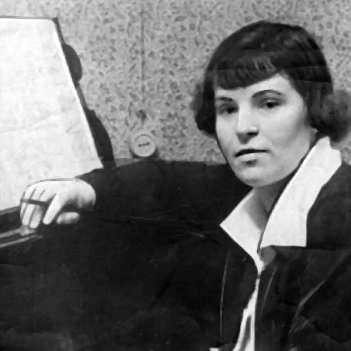
Galina Ustvolskaya: Concerto for piano, strings and timpani
"It's not you who are under my influence, it's me who is under yours". This quote by her teacher Dmitri Shostakovich has become the defining words for the relationship between himself and his pupil, Galina Ustvolskaya. The "teacher-pupil" dynamic notwithstanding, for her own part, Ustvolskaya spent her life trying to distance herself from her violent relationship with Shostakovich. This seems an obvious sign of sincerity, the pursuit of impartial and unrestrained untamedness of the composer. These adjectives also certainly best describe the few works that make up her comprehensive output, which made themselves known without adapting to any one style. Though she rarely left her hometown until her death in 2006, she was a part of the music scene in St. Petersburg both under Soviet regime and after its collapse - an enigmatic phenomenon untouched by all political or aesthetic trends. In her case, she chose the life of an outsider completely of her own accord. Ustvolskaya did not tolerate any superficial interference, according to the musicologist Olga Gladkova, out of a desire to maintain her own individuality, compoure, and intentions. Therefore she never took commissions, on the contrary, she refused even partial interpretations of her work if the composer did not appear "real" to her.
Especially in her "Concerto for piano, strings and timpani", written in 1946, the composer starts to withdraw herself from her academic influences, to strike a new path, and to find completely new ways of expression. It is not without motive that she decided to start her official list of works with this concerto. The first noticeable feature is the single-piece form, which is described by the composer as cohesive but still contrasting.
The opening theme is highly concentrated within the Rhythm. No notes seem to be wasteful. The piano breaks out of the silence like an explosion with the specific dotted thirty-second notes in fortissimo that are repeated in unison by the orchestra and which are concluded by the timpani. All the followings motives are developed from the basic theme. Olga Gladkova compared the concentrated main theme with a nuclear reaction - after the explosion many infinitely small atoms are produced, instantaneously destructive and creative. Close beside is a plain melody in subito - pianissimo, circling around itself, not leading anywhere. This is a very fundamental characteristic of the later works by Ustvolskaya. The second theme, which branches out wildly, seems to come rushing in a fugue. But academic processes and stencils are avoided consequently and the fugato is being constantly taken to explore new avenues, like a kaleidoscope, out of which unexpected new pictures are formed. In addition to the rigid and concentrated 4/4 measure, the quiet secondary theme is at the quietly flowing 6/8 measure. The "continuity", which is described by the composer, happens also by the very strong contrasts.
Especially remarkable is the coda of the concerto. The rhythmically striking dotted thirty-second notes are taken from the initial theme and with full force repeated again and again.
An unprecedented massive structure comes into being, which instead of running to the disaster leads into a C major chord, which appears at the moment of most extreme tension and repeats in a big crescendo until the end. The immense focus on one rhythm, the constant repetition of this rhythm and the unbridled force of it, speaks to the forementioned monstrous new language of the composer.
Although the great crescendo of the coda is written in C major, it seems to evoke various kinds of associations. In the dialogue with the young musicians of the ensemble, I would like to describe three different impressions. On the one hand there is the feeling of generous grace, of forgiveness, the cathartic effect after a prayer. Facing this sensation is the feeling of being threatened by a wall that is approaching you relentlessly, without ability to escape. The third association is similar to the theme of Shostakovich's Fifth Symphony - forced rejoicing, created under threat. An eagerly awaited end of the war, but an ending with terror.
Peter Leipold
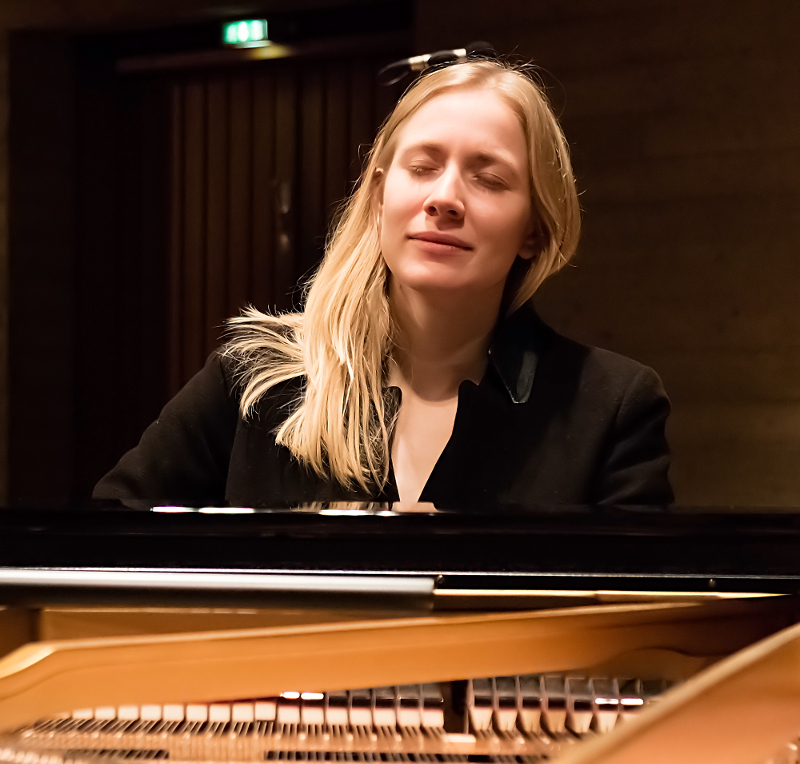
B
ridging distances, bringing music closer to the people in a completely natural intimate way - these are the strengths of the pianist Patricia Hase, born in 1989 in Wiesbaden. Educated in one of the talent-hotbeds of the international piano elite at the Hanover University for Music, Drama and Media in the studio of Matti Raekallio, the young musician has set for herself the task of establishing through her music the connections between highly intellectual works of Western culture and the everyday life of the listener. In doing so she captivates with her warm sound, profound interpretations, and mature virtuosity. In addition to her pet project, the interpretation of the works of Franz Schubert which are celebrated by the press and public, Patricia likes to forge a bridge between "past" and "present", such as this recording, which ranges from the 1770-born Ludwig van Beethoven to Galina Ustvolskaya, who died in 2006.
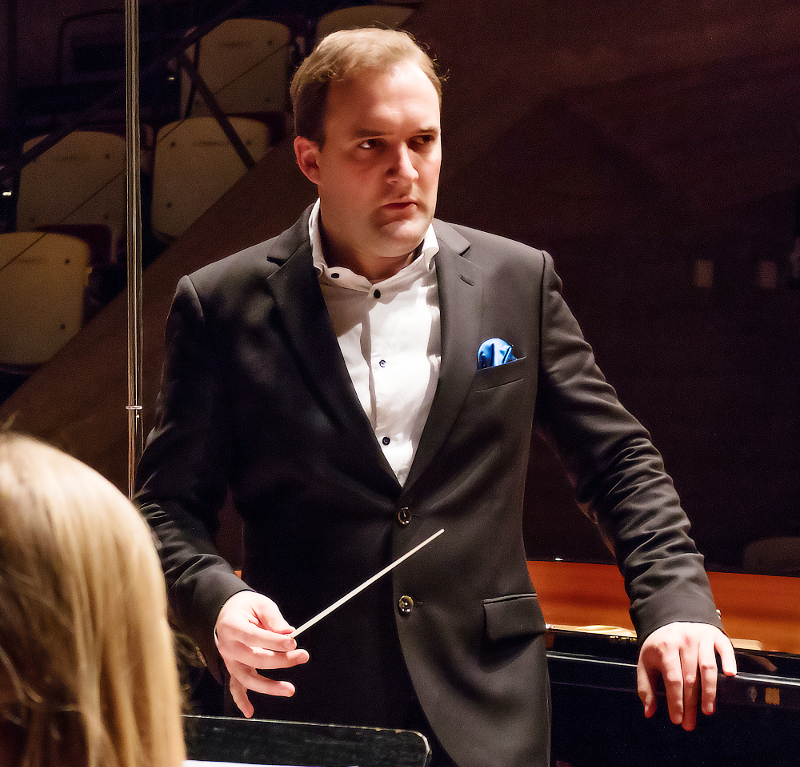
S
ince the beginning of her studies Patricia Hase has enjoyed a close friendship with the conductor Peter Leipold, born 1987 in Stuttgart. Since then, numerous concerts have led the two young musicians throughout Europe. The work of Peter Leipold, who started his career at the Theater Erfurt and was honored by the Hannoversche Allgemeine Zeitung for his "quality of musical fine drawing", fascinates in his role as a seeker of and servant to the rich facets and colors of music that can be unveiled in the score and by the orchestra, as a conductor who represents the bridge between the musical performer and the score. With the recording of "Concerto for Piano, Timpani and String Orchestra" by Galina Ustvolskaya, Peter Leipold follows his passion for new music, on which he already specialized during his conducting studies for music of the 20th and 21st centuries at the Conservatorio della Svizzera Italiana in Lugano.
Ensemble Galina - the search for harmony
The Ensemble Galina was founded in October 2014 and formed out of the desire to make music at a level where the quality of music and friendship come together. The young chamber orchestra is made up of 18 musicians - music students and emerging professionals from all over Germany. With the pianist Patricia Hase and the conductor Peter Leipold the ensemble makes it its mission to inspire a new sense in the musical performance - searching for harmony in the dialogue between soloist and ensemble and between composer and performers, honoring the true sense of the word »concertare«. For the name of the ensemble, they chose the Russian composer Galina Ustvolskaja (1919-2006), her »concert for piano, strings, and timpani« becoming the foundation stone on which the Ensembles was built. Ustvolskaja, who had to fight for cultural survival as a composer under the Soviet Regime touched us musicians not only with her life story, but with her music’s unbelievable emotional approachability, sincerity, and depth. The urgency in her existential musical expression became a very special motivation for the young musicians. To inspire true emotion as well as to search out interesting contemporary forms of expression are the goals and purpose of the Ensemble. With this new approach, which is shaped through collective dialogue and musical discourse, the Ensemble Galina endeavors to preserve the great cultural property in our time.
Peter-Lukas Gebert
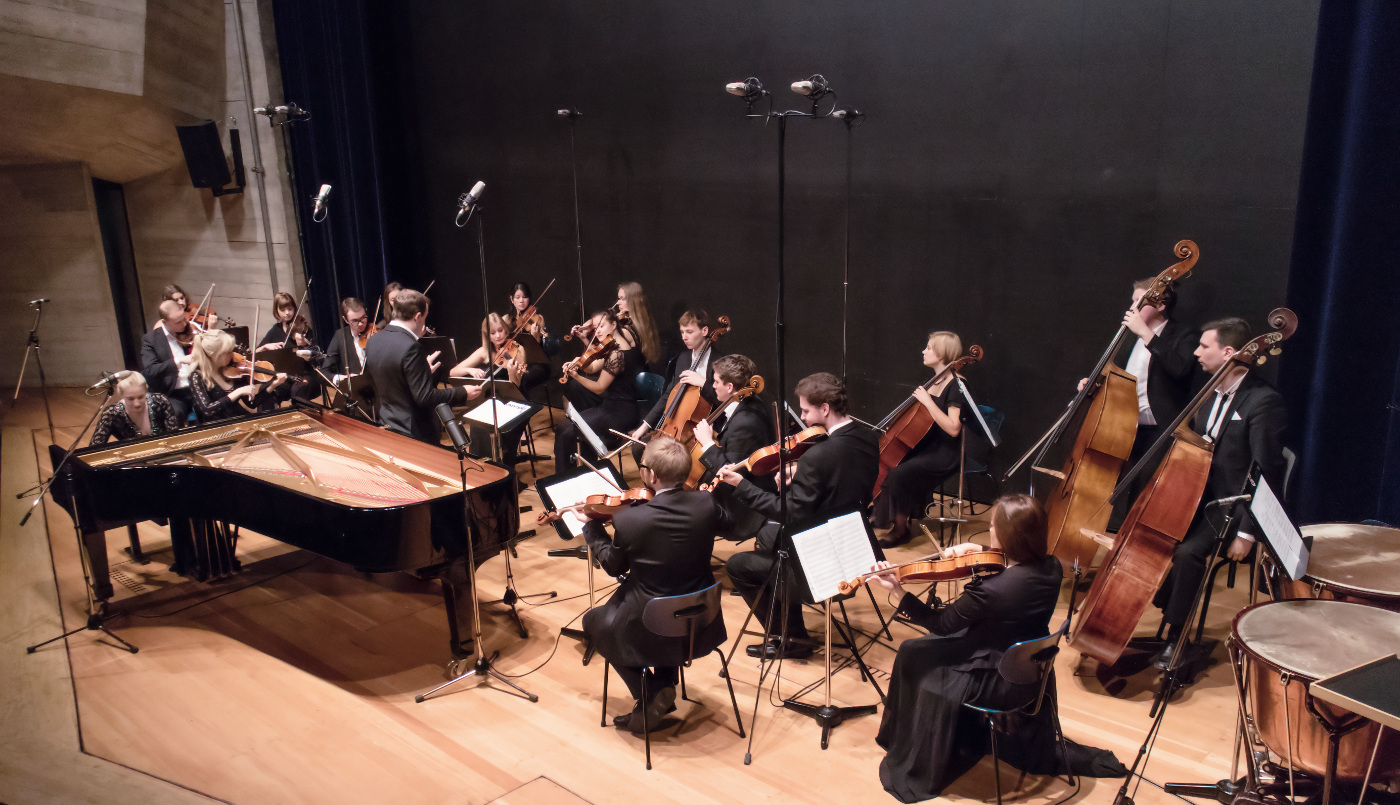
Ensemble Galina · Members
Violin: Friederike Jahn (Concert Master), Rebekka Gebert, Florian Giering, Emilia Grotjahn, Cornelius Köhler, Erika Lunz, Alina Riegel, Friederike Schindler, Saskia Becker-Foß, Inara Waiss
Viola: Peter-Lukas Gebert, Julia Yeon-Joo Oh, Raphael Tietz · Cello: Ingmar Escher, Inka Jans, Jaromir Kostka
Double Bass: Hermann Haffner, Lukas Rudolph · Timpani: Jonas Krause
The Ensemble Galina is supported by the "circle for the promotion of the Hanover University of Music, Drama and Media e.V.", the banking house Hallbaum,
the Wellness-Hotel Diedrich in Hallenberg (Sauerland) and the "funding pool gender of the Hanover University of Music, Drama and Media".
P
ublishing Authentic Classical Concerts entails for us capturing and recording outstanding performances and concerts for posterity. The performers, audience, opus and room enter into an intimate dialogue that in its form and expression, its atmosphere, is unique and unrepeatable. It is our aim, the philosophy of our house, to enable the listener to acutely experience every facet of this symbiosis, the intensity of the performance, so we record the concerts in direct 2-Track Stereo digital HD. The results are unparalleled interpretations of musical and literary works, simply - audiophile snapshots of permanent value. Flourishing culture, enthralling the audience and last but not least also you the listener, are the values we endeavor to document in our editions and series.
The concert grand piano is incontestably the king of instruments. We could now wax lyrical about its incomparable dynamics and go into its ability to go from the tenderest of sounds in a soft minor key to the magnificent power of a fortissimo, or I could rhapsodise about its impressive size and elegance. But what makes this instrument really fascinating is its individuality, since each one is unique in itself - created by a master. A concert grand has a life all of its own that a virtuoso can really "get into" and hence bring the work of the composer to life. In our Grand Piano Masters Series, we get into the character and soul of the concert grand piano and experience, during the performance itself, the dialogue between the instrument, the virtuoso and the performance space.
Andreas Otto Grimminger & Josef-Stefan Kindler, K&K Verlagsanstalt
Ludwig van Beethoven (1770-1827):
Piano Concerto No. 2 in B-Flat Major, Op. 19
Arranged for Piano & String Orchestra by Vinzenz Lachner (1811-1893)
1. I Allegro con brio [14:38]
2. II Adagio [9:03]
3. III Rondo. Allegro molto [6:21]
Galina Ustvolskaya (1919-2006):
Concerto for Piano, Strings & Timpani
With courtesy of Hans Sikorski Music Publishing Hamburg
4. I Lento assai - II Allegro moderato [3:00]
5. III Andante (cantabile) - Pesante - Cadenza [4:54]
6. IV Largo - Tempo di Allegro moderato [4:52]
7. V Grave - Pesante [4:56]
8. Applause [0:54]
Recorded to 'Direct 2-Track Stereo Digital' in a concert at the Richard-Jakoby-Hall of the Hanover University of Music, Drama and Media in Germany, recorded, released & created by Andreas Otto Grimminger & Josef-Stefan Kindler.
Concert Date:
October 26, 2015
Sound & Recording Engineer:
Andreas Otto Grimminger
Mastering:
Andreas Otto Grimminger & Josef-Stefan Kindler
Photography, Artwork & Coverdesign:
Josef-Stefan Kindler
English Translations:
Catie Leigh Laszewski

Featured on Spotify
This release is featured in the editorial playlist on Spotify:
COMPOSER WEEKLY: GALINA USTVOLSKAYA

***** Wonderful performance and very good recording quality
Wonderful performance and very good recording quality. I love the beauty of the interpretation and the combination of the two works!

Featured on Spotify
This release is featured on the Spotify list of 50 notable classical new releases

The first recording played without blunders is out!
The first recording of the Concerto for Piano, Strings & Timpani played without blunders is out!

The Hannover-based pianist Patricia Hase has just released the Grand Piano Masters: Concertos by Ludwig van Beethoven (1770-1827) & Galina Ustvolskaya with conductor Peter Leipold and Ensemble Galina in with the record label K&K Verlagsanstalt this summer. A coffee addict and an avid reader who listens to German rap band Cro when she works out, Patricia tells primephonic’s Rina Sitorus about the new recording and her biggest wish in music.
Could you tell us about your newest album?
It’s very special for me to have recorded this album, because the conductor Peter Leipold and I are very close friends for many years now. It is so special for me to have this album recorded with him and the orchestra, Ensemble Galina. These wonderful concertos of Beethoven and Galina Ustvolskaya are two works which I'm addicted to.
Beethoven really is one of my favorite composers. It feels very natural for me to play his music. His early concertos are so fresh and full of spirit. The orchestra is young, the conductor is young, and I am young, so it was great to bring the spirit out of Beethoven's early works from his younger years. And Galina Ustvolskaya is one of the most impressive composers I've ever encountered. She was so strict and her music is uncomprimising, which really impressed me. I have a feeling that she really wanted to say something and not just merely make nice music.
The combination comes naturally - both works were written when the composers were young. I find that music written in that time of a person’s life actually says so much about our world today. It's hard to say which one I like better, I like both works just as much.
You mention that the music is a reflection of the world today. Could you elaborate on that?
I think the main themes are always the same: love, passion, death, religion. What Beethoven wrote are the same main themes which belong to us today. It's really important to show the audience that his music is absolutely modern and it is important for us to get connected to our feelings and our lives.
With all that in mind, I suppose you had had some kind of overall theme or mood in the back of your mind prior to the recording. Are you pleased with the final outcome?
Yes I had a very clear idea of how it should sound and how the music should feel. I was very hard on myself during the preparation – everything had to be better and better. But then, this recording was special because it was a live recording, so we only had one chance to get it right. So I stopped thinking when I entered the stage. My wish in that moment was to give everything I have and to leave my heart at that place, at that moment. Beforehand, I had been thinking it through so much, but once it started, I just let go, had fun and felt what was in the air. Maybe that’s what music is all about.
I hope one can hear that from the album.
Tell me about the audience during the recording.
It is always so interesting to see the audience. Their reactions are always so different every time. Every concert is very different but there is always a special atmosphere.
I remember the audience during the last recording so well. It was so quiet in the hall. It was in my hometown, Hannover, and there were many people in the audience who I knew. They were crossing fingers and I could feel that!
It was also so nice that backstage, right before we started, we all came together, for a big hug and I had the feeling that we had a great connection together. I had a feeling that everybody would give the best of what he or she can. It was such an amazing feeling, knowing that everybody wants to give their best.
How would you describe the collaboration between you, Peter Leipold and Ensemble Galina?
Well, Peter and I know each other for many years and I learned so much about music from him. I performed my first piano concerto with him conducting. Then there was a time when we were just thinking: ‘We know so many wonderful musicians, why don't we bring them together and see what happens?’ We are professional colleagues but we are also really good friends with a good connection. I think people can hear it on the album, that when we come together, there is such a nice atmosphere. To play this first recording with so many friends on stage playing together was so amazing. I feel so proud when I see the album.
Is it too early to ask about how the reaction to your latest album has been?
We got so much feedback – the media wrote very very nice things about us! Konstantin Bagrenin, Galina’s widower, wrote us a letter and he was really impressed and that his wife would have loved it. I think I could cry!
What can we expect in the near future?
The label KuK wants to make another recording with me and maybe with the orchestra. We are still brainstorming about the project, but we have cool ideas, though we have to keep it secret at the moment. But don't you worry, more is coming!
What about your own project(s)?
Well I have a lot of concerts planned, and there is a possibility of a solo recording. It could be Schubert, my other favourite composer.
Where will you be in 10 years?
I hope I can play piano and continue being on stage for my whole life. It'll be great if I get the chance to make music and keep going in this very special and wonderful direction. But you never know what’s going to happen. I'm completely relaxed, so we'll see – the rest will come.
Any names you'd like to work with?
I really really like the violinist Isabelle Faust. It would be great for me to play with her, and I also really like the pianist Maria João Pires. I think she's so absolutely amazing. And so many conductors! Maybe to play once with the Berlin Philharmonic – of course that is the dream of every musician, I think. I played a lot with horn player Felix Klieser. These were such amazing experiences and maybe there's another chance to play with him again.
What do you do when you're not busy with recordings or concerts and how do you balance your music with other obligations, such as friends and family?
I really like to play sports and I'm addicted to coffee and chocolate. Sitting in a cafe, having a nice coffee while talking to a friend: that is the real Patricia. And I also like reading: from criminal stuff to music, biographies, funny stuff; I read everything!Balancing my music with the rest is much easier than I had thought it would be. I have many friends from all over the world which is perfect, since in most cities I play, there is somebody I know. I'm very connected to them through technology. And my family lives all over the world, so I'm used to that. I think the point is, they've already known me this way since the beginning. Because I also make music together with friends, we can combine friendship and the work. Sometimes during rehearsals with the orchestra we really have to be careful that we are not only talking about other [non-musical] stuff. People bring cakes, and during break we can talk about 'important private' stuff!
What is your biggest wish as a musician?
To break the distance between the audience and the people on stage. Sometimes I feel that the people in the audience are just watching the people who are on stage, so I find it important to get everything connected.
How would you achieve that?
I often talk to the audience and explain something about the works. Other times I tell them what I feel when I play, or just ideas of what it could be and leave it open, so that we can discuss it afterwards. For me it is interesting to know what the audience thinks. It makes it more alive and brings it closer to the present day.

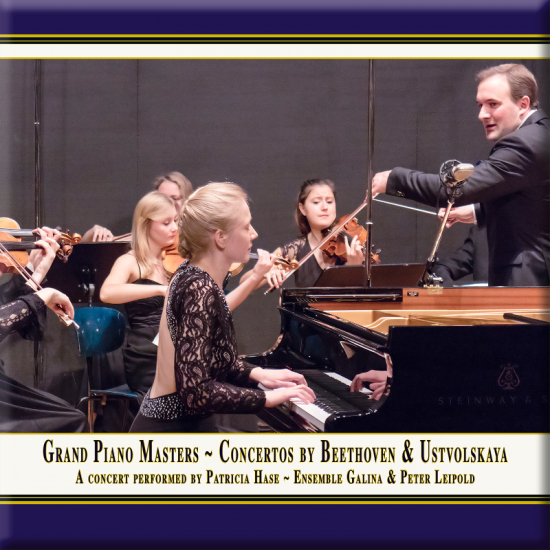



Featured on Spotify
6. March 2018 - 12:37 — kuk-art.comCOMPOSER WEEKLY: GALINA USTVOLSKAYA
https://open.spotify.com/user/spotify/playlist/37i9dQZF1DX21bRPJuEN7r
This music makes me smile! - An ear-opening album...
25. October 2016 - 13:06 — kuk-art.comThe Beethoven is happily heard in the chamber reorchestration by Vincenz Lachner in 1881, a first recording on CD.
The album, for the record, is entitled Grand Piano Masters, Concertos by Beethoven & Ustvolsakya (K&K Verlagsanstalt, KuK 123).
This is a live recording from the Hanover University of Music this past October, 2015. It has a beautiful ambiance and everyone, clearly, is inspired.
The string orchestra arrangement of the Beethoven gives the work an intimate sweetness and fire which is intensified by the sparkling brilliance of Patricia Hase, who sounds positively angelic in her performance.
The Galina Ustvolskaya (1919-2006) work further reminds us that her time has come. I covered a recording of her solo piano works earlier (see search box) and was tremendously impressed. The Concerto only confirms that initial encounter with a swell of original, majestic and unsettling luminescence that confirms her as no Shostakovich clone (whose pupil she was) but rather a Russian dynamo in her very own light. Hase and Ensemble Galina unfold the tremendous expressivity of the work so that we feel the enormous creative force unleashed by Ustvolskaya in no uncertain terms. The climax is riveting, unprecedented for the time, still packing an enormous catalytic punch.
The end result is one ear-opening album that affirms Patricia Hase as a lyrical marvel and expressive titan, with Ensemble Galina under Peter Leipold a youthful torrent of energy and sensitive passion. The Beethoven is revelatory, the Ustvolskaya even more so.
This music makes me smile!! I recommend it to you on multiple levels without the slightest hesitation.
Music Review by Grego Applegate Edwards on Gapplegate Classical-Modern Music Review
Interview with Patricia Hase on primephonic
3. September 2016 - 19:40 — kuk-art.com>>> READ THE COMPLETE INTERVIEW HERE
The first recording played without blunders is out!
23. August 2016 - 14:38 — kuk-art.com'Galina Ustvolskaya official' on Facebook
***** Wonderful performance and very good recording quality
31. July 2016 - 16:39 — kuk-art.comAn Amazon Customer on July 31, 2016
(5 stars out of 5)
Featured on Spotify
6. July 2016 - 13:29 — kuk-art.comhttps://open.spotify.com/user/spotify/playlist/4gWfh2NYhzzJ9NGP9D9fHE